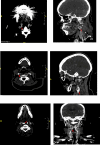In-hospital recurrent stroke in ipsilateral carotid web patients undergoing thrombectomy
- PMID: 39215397
- PMCID: PMC11537123
- DOI: 10.1002/acn3.52161
In-hospital recurrent stroke in ipsilateral carotid web patients undergoing thrombectomy
Abstract
Objective: Carotid artery web is a possible cause of ischemic stroke, especially in young patients who lack conventional risk factors. The immediate and long-term outcomes are not well studied. We aimed to determine the association between an ipsilateral carotid web and in-hospital stroke recurrence.
Methods: We analyzed data from adult patients admitted with an acute anterior circulation large vessel occlusion at a Comprehensive Stroke Center between July 2015 and March 2023. The primary outcome was in-hospital stroke recurrence and secondary outcome was in-hospital recurrent LVO. Multivariable logistic regression was performed to examine the association between ipsilateral carotid web and recurrent ischemic stroke and recurrent LVO.
Results: Of the 1463 patients with anterior circulation large vessel occlusion, 27 (1.8%) had an ipsilateral carotid artery web. Patients with carotid web were younger (median age (IQR), 60 years (53-67 years) versus 74 years (62-84 years), P < 0.01) and less likely to be Caucasian (60% vs. 80%, p = 0.014). Of the 27 patients with carotid web, 18 (70%) had no identifiable competing stroke mechanism. When compared to patients without ipsilateral carotid web, those with an ipsilateral carotid web had a higher risk of recurrent ischemic stroke (adjusted RR: 4.38, 95% CI: 1.38-13.85) and recurrent ipsilateral large vessel occlusion (adjusted RR: 4.49, 95% CI: 1.41-14.21).
Interpretation: Carotid webs are an under recognized cause of acute large vessel occlusion and are associated with higher risk of early recurrence. Studies are needed to validate our findings and test early revascularization strategies in patients with symptomatic carotid artery webs.
© 2024 The Author(s). Annals of Clinical and Translational Neurology published by Wiley Periodicals LLC on behalf of American Neurological Association.
Conflict of interest statement
None.
Figures
References
-
- Wirth FP, Miller WA, Russell AP. Atypical fibromuscular hyperplasia. Report of two cases. J Neurosurg. 1981;54(5):685‐689. - PubMed
-
- Kim SJ, Nogueira RG, Haussen DC. Current understanding and gaps in research of carotid webs in ischemic strokes: a review. JAMA Neurol. 2019;76(3):355‐361. - PubMed
-
- Wang LZ, Calvet D, Julia P, et al. Is carotid web an arterial wall dysplasia? A histological series. Cardiovasc Pathol. 2023;66:107544. - PubMed
MeSH terms
LinkOut - more resources
Full Text Sources
Medical



